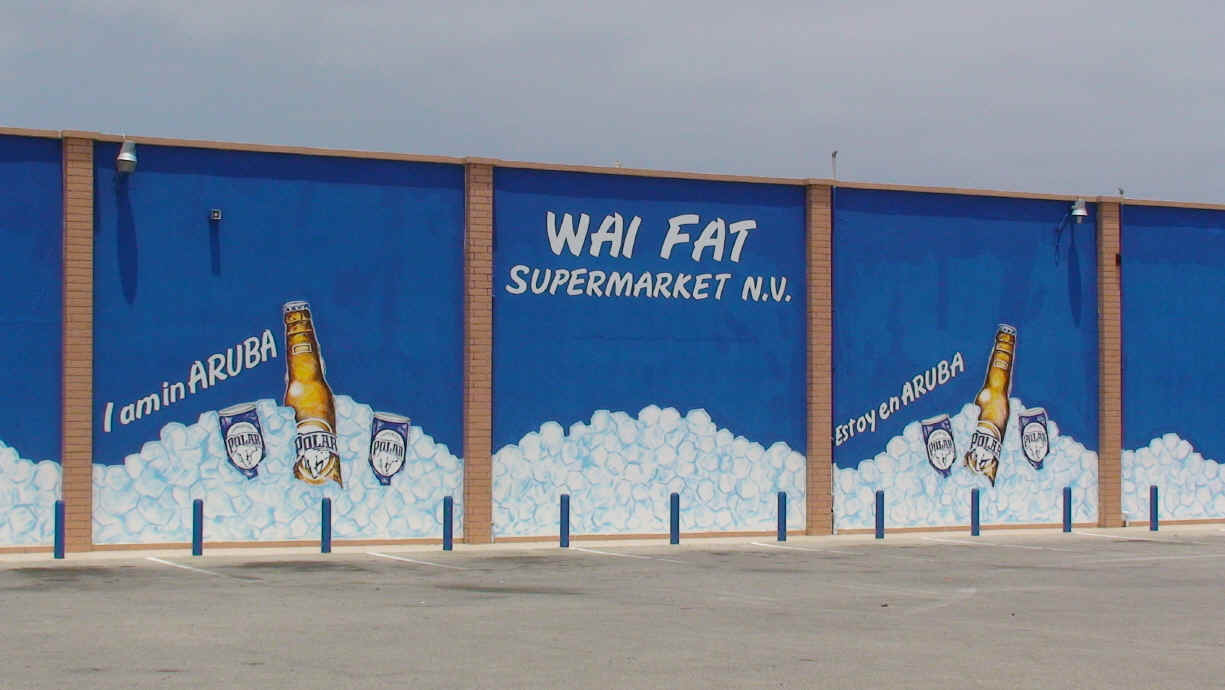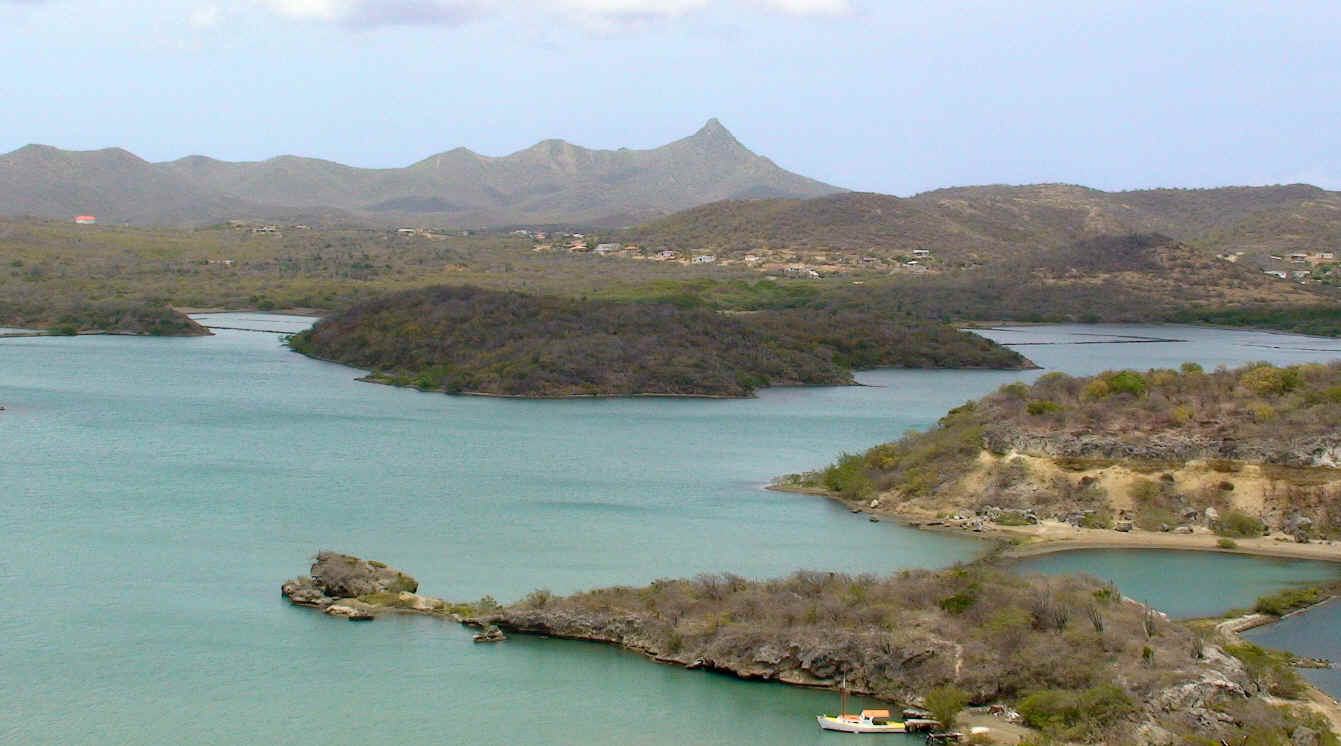
A Trip to Curaçao -- page 2
The next day was my day to explore the wild west. The whole western end of the island is sparsely populated, and has the best scenery and the highest mountains. This is where the Mt. Christoffel National Park is, which is the highest mountain on the island. The mountain wouldn't attract much attention in our country, but after driving for quite a while, I really went "Wow!" at the first sight of it, compared to all the other hills around. But first I needed some money from an ATM, some gas, and some food. I drove all the way around the end of the island, which was quite scenic and impressively green compared to most of the rest of it, before I managed to get any of those things. Then I went back to the parking lot of the national park, ate my Dutch cheese and passionfruits, then went to get the park information. They were closed. It was 2:30 pm on Friday! Who closes a national park at 2:30 in the afternoon? But they did. So I just drove around the whole west end of the island again, circling the mountain. I might not have missed much by not going up it, but still....

There are wild goats everywhere:

Datu and kadushi cacti are all over the island:




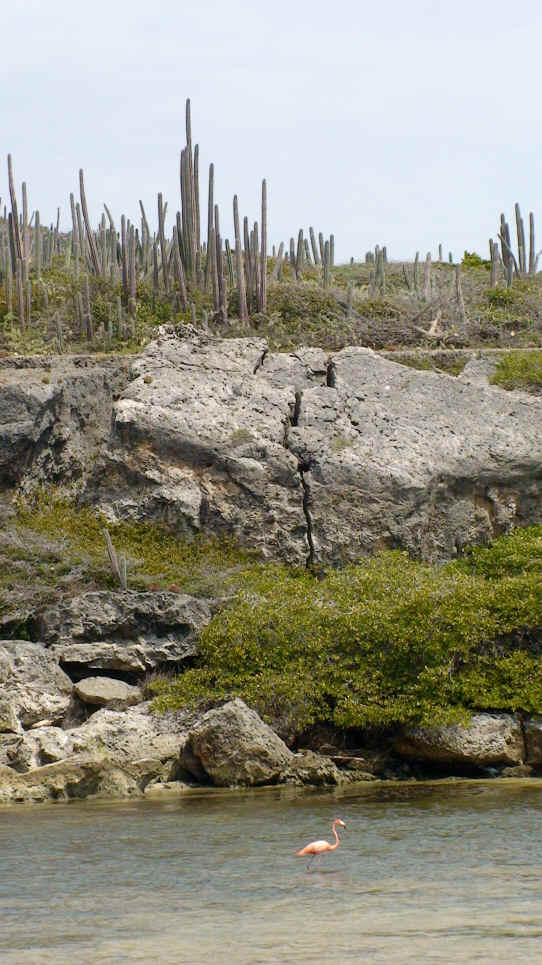
The westernmost point of the island is called Westpunt (West Point, duh...). The beaches there are no better for sunbathing and swimming than those on the north side, but again, they are very scenic, with coral tidal terraces and eroded cliffs.
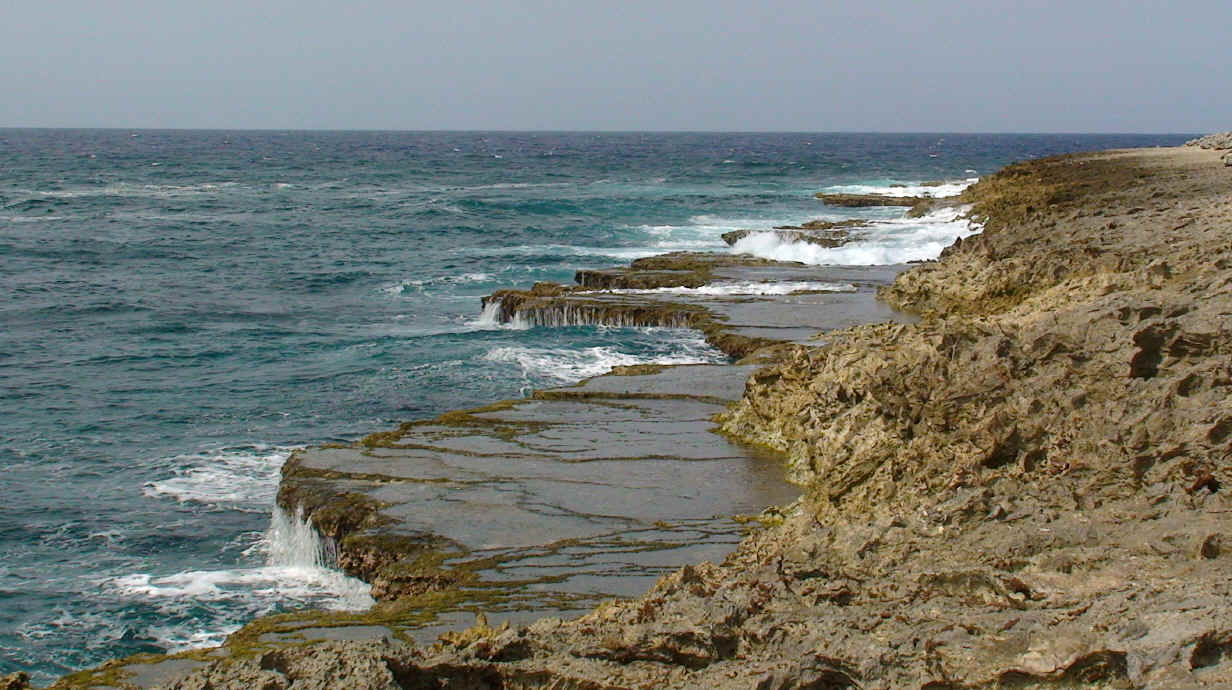
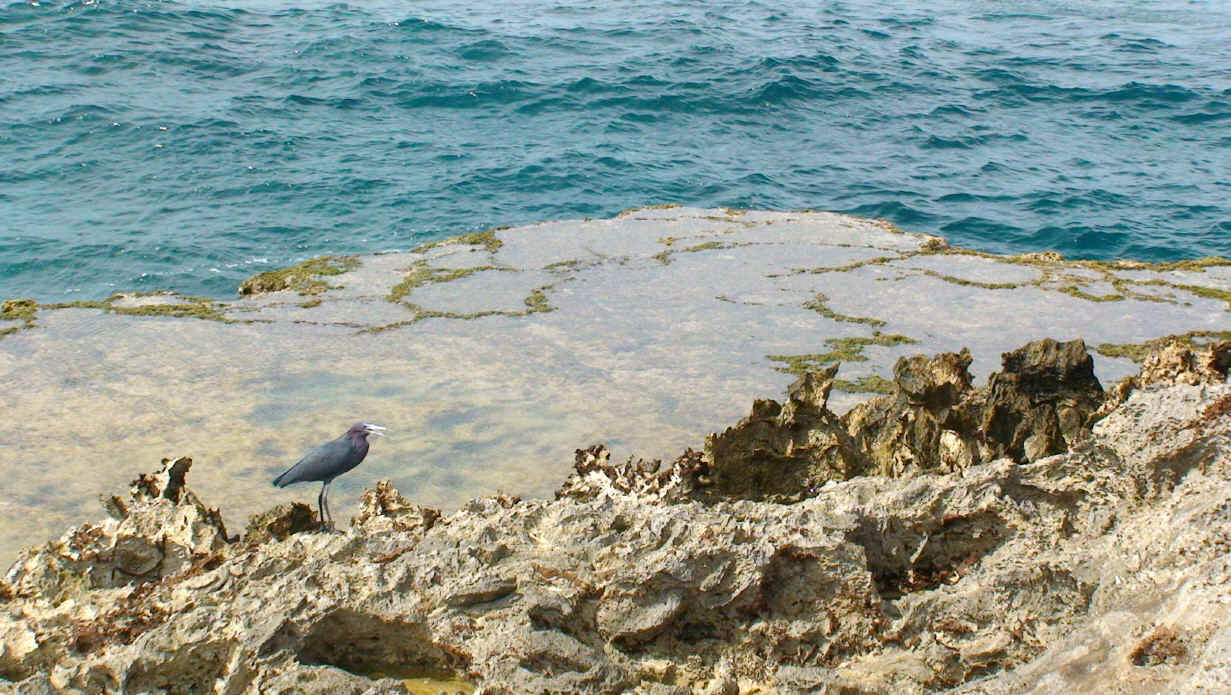
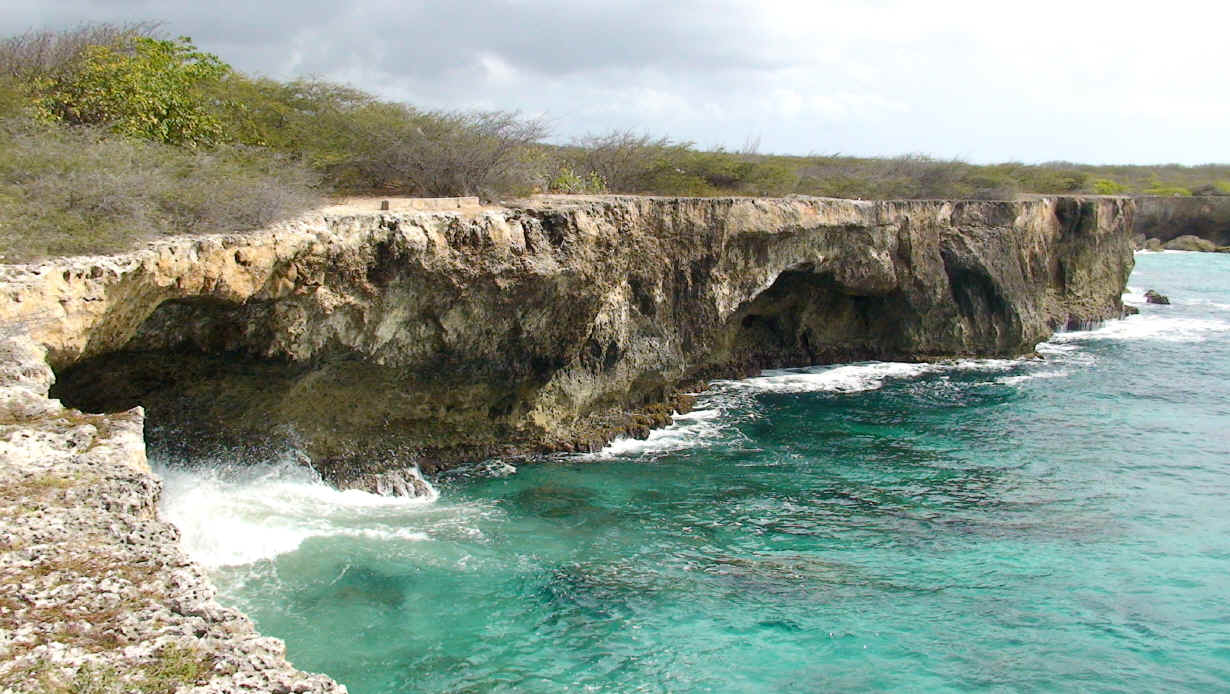
This was the day I discovered the landhuizen -- the land houses. They are the equivalent of our old plantation houses in the deep southern states, the elegant homes of the rich landowners. They don't look a bit like the old US antebellum houses though; they are built in a Dutch colonial style, and often have hilltop locations and can be seen for miles. The first one I passed was Ascension, then later I saw St. Nicholas, Kenepa, Jan Kok, Santa Barbara, and Savonet. Some are still inhabited, some are museums, and some are hotels now. But while driving aimlessly on a dirt road near a beach on the north side, I found some sad ruins -- the abandoned landhuis of Santa Catarina. It had been beautiful in its day -- simple, but large and elegant, with a high view over the hills and out to the Caribbean. Now it is an utter wreck, with the entire south side of the roof completely fallen through. It is the home of hundreds of wasp nests and dirt daubers. The floor boards are cracked, rotten, and missing. The cistern is wide open and full, but reeking with slime and algae. The great front patio, once no doubt the scene of many a fine dinner party, was a mess of shattered pavement, with trees and cacti pushing their way through the cracks, shoving the walls down into the deep ravine below. I wandered around for an hour; it was more fascinating than any of the well-restored ones I had seen.
Ascension
House:
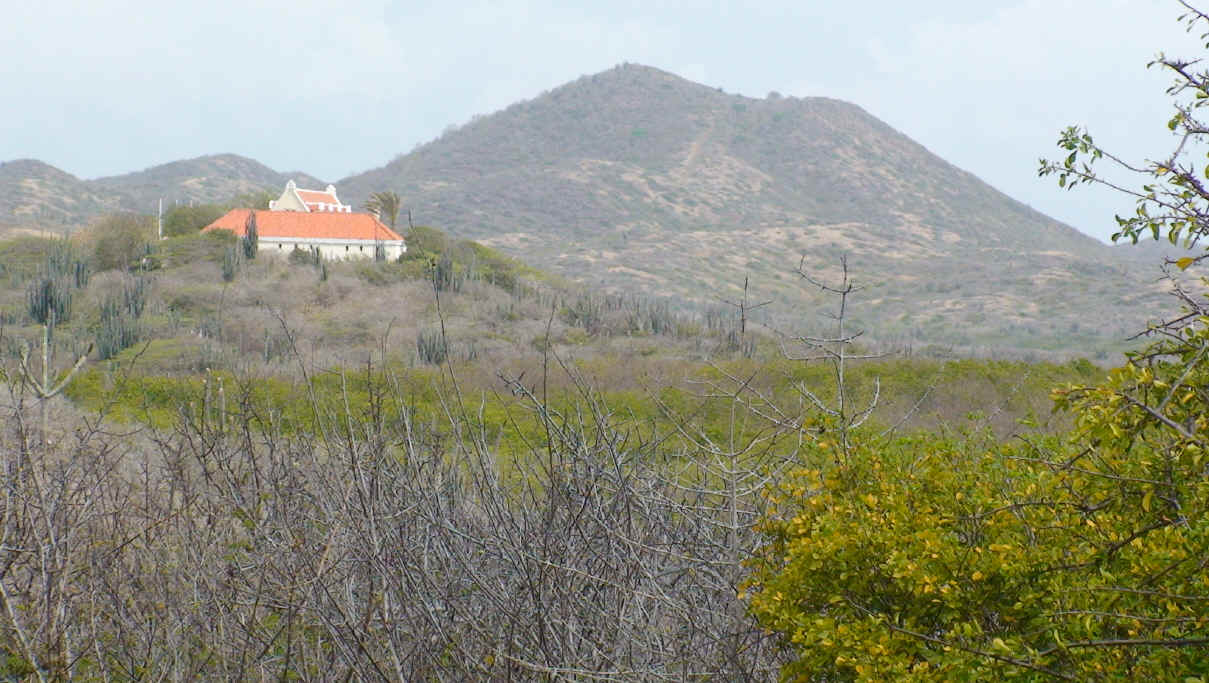
Ascension
House:
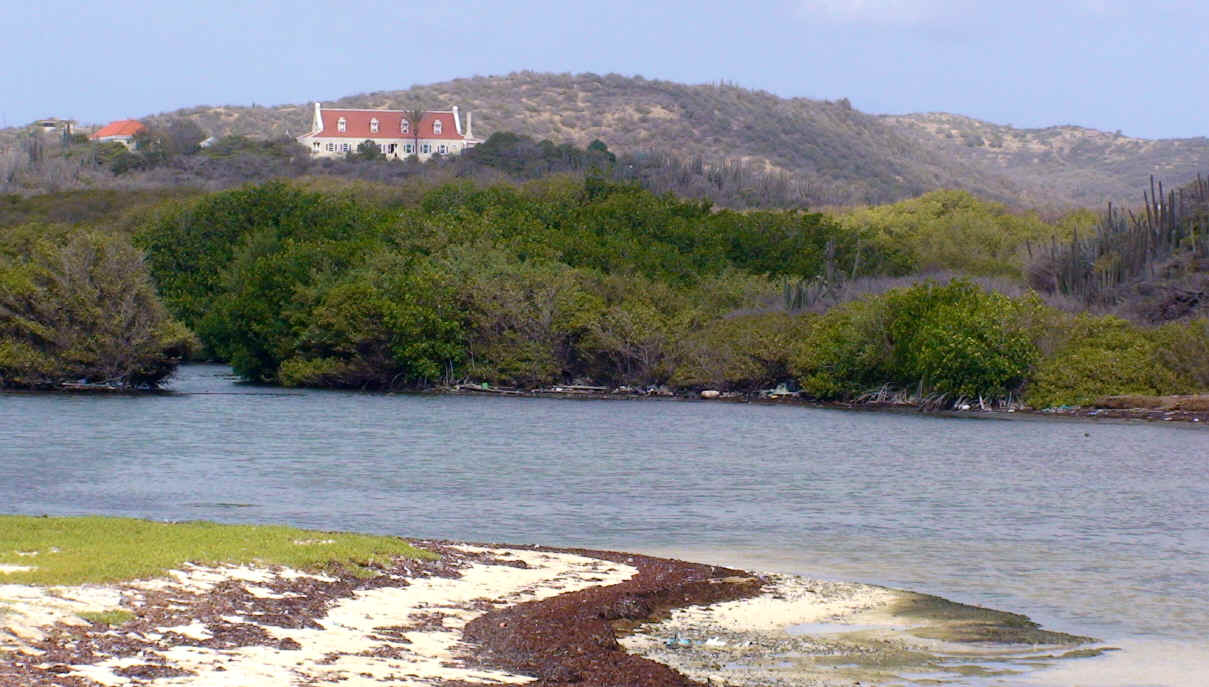
Santa
Barbara House:
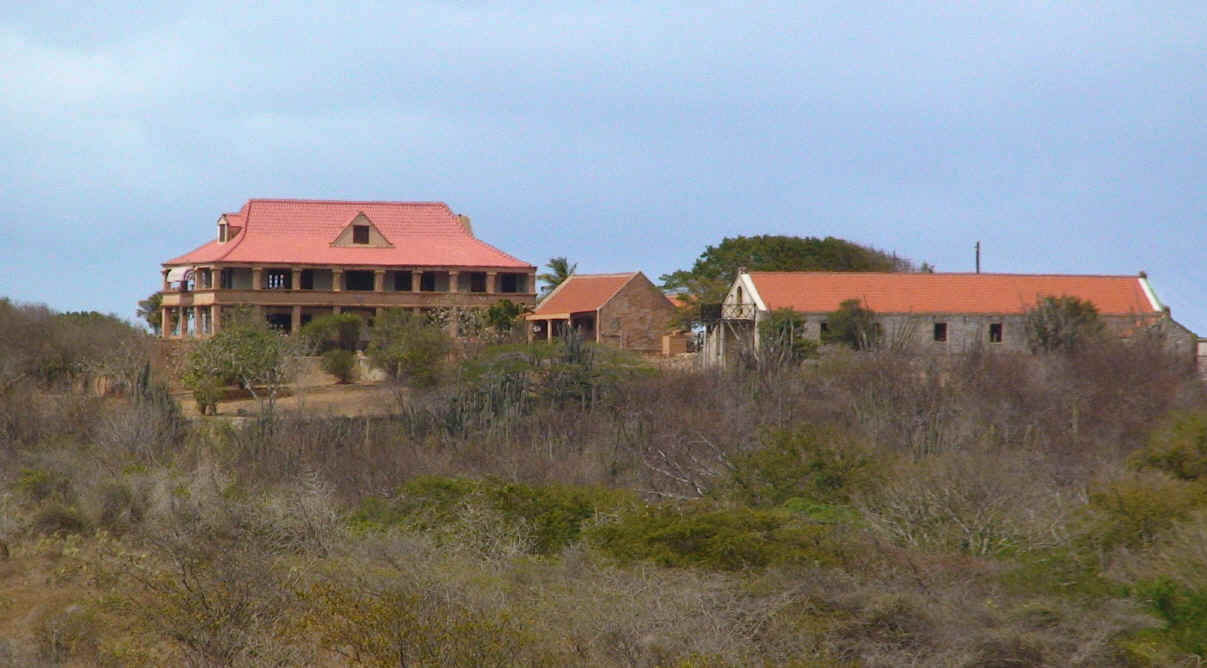
Santa
Barbara House:
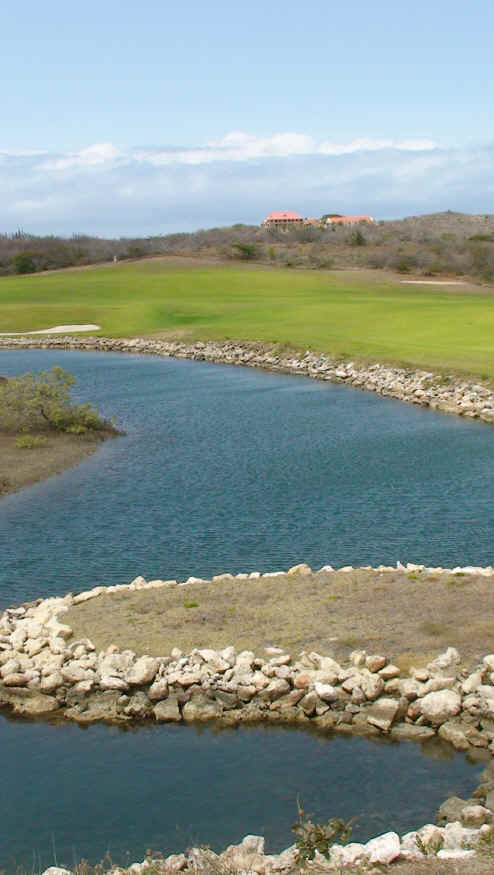
The
Santa Barbara House and a Divi-divi tree:
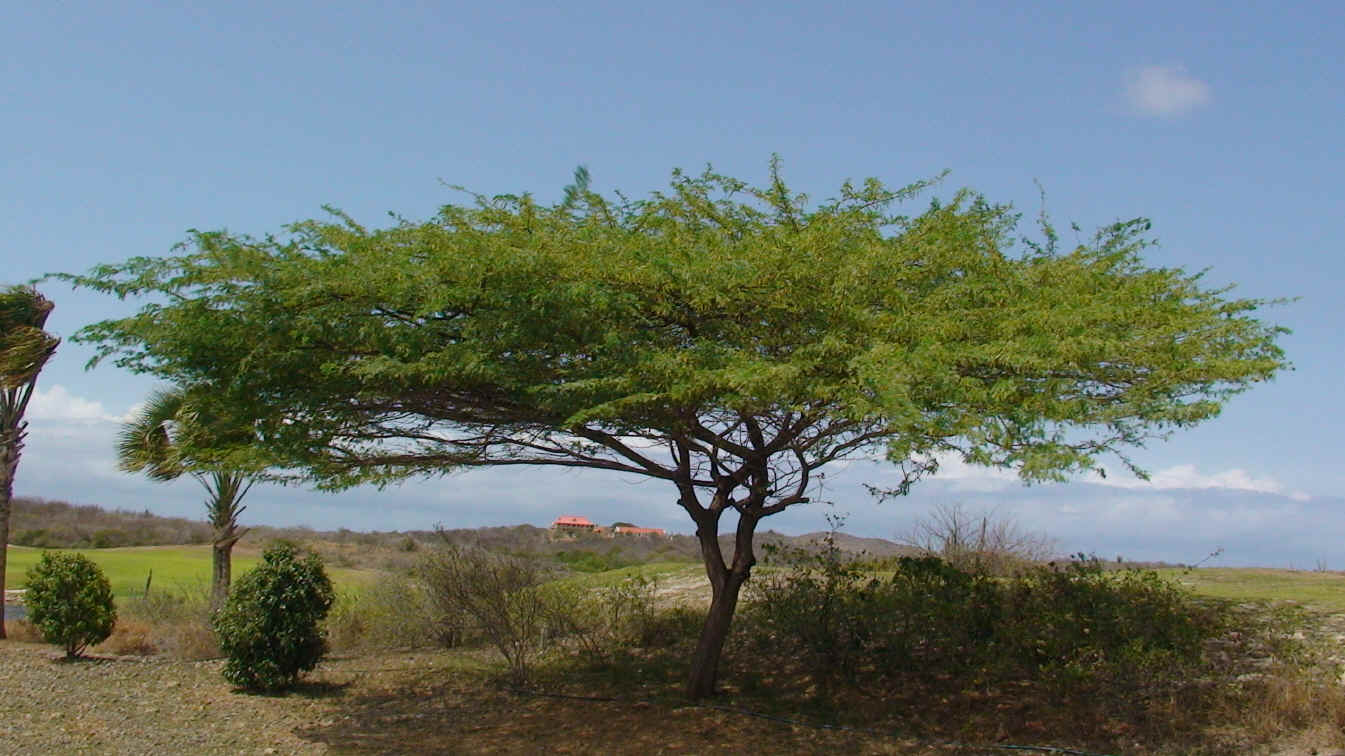
Kenepa
House:
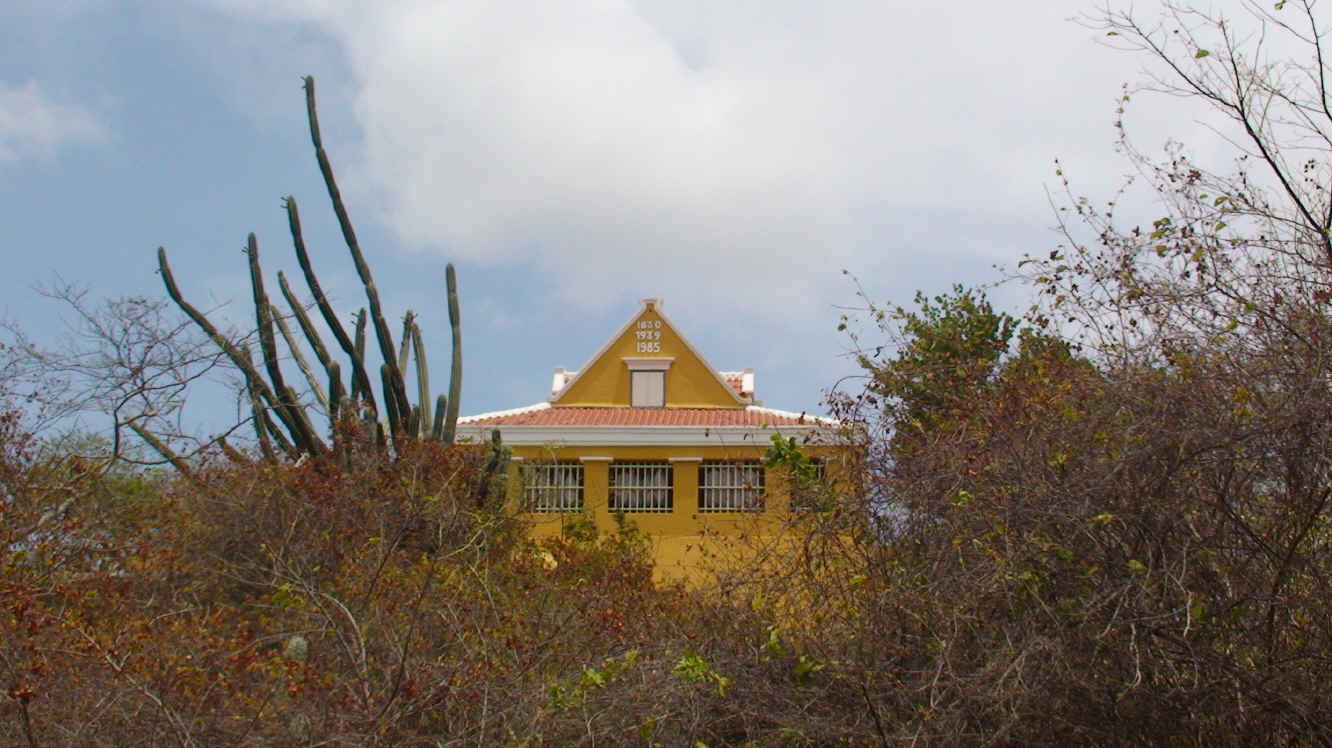
Jan Kok
House:
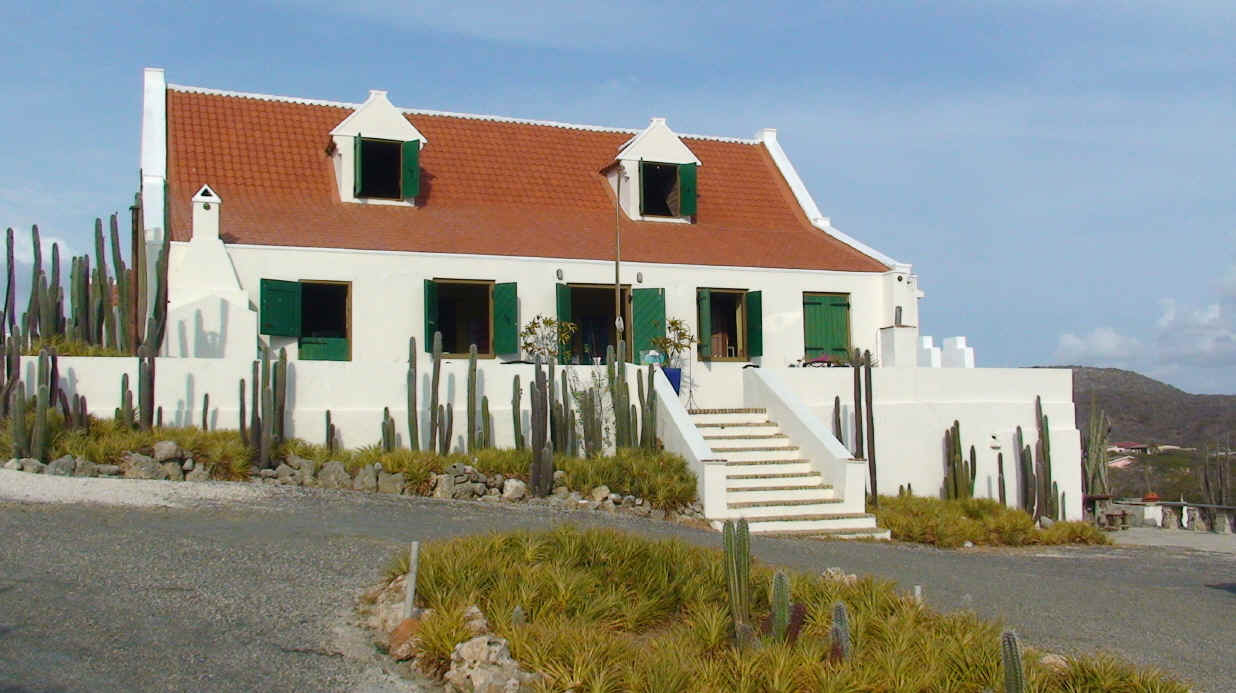
Jan Kok
House:
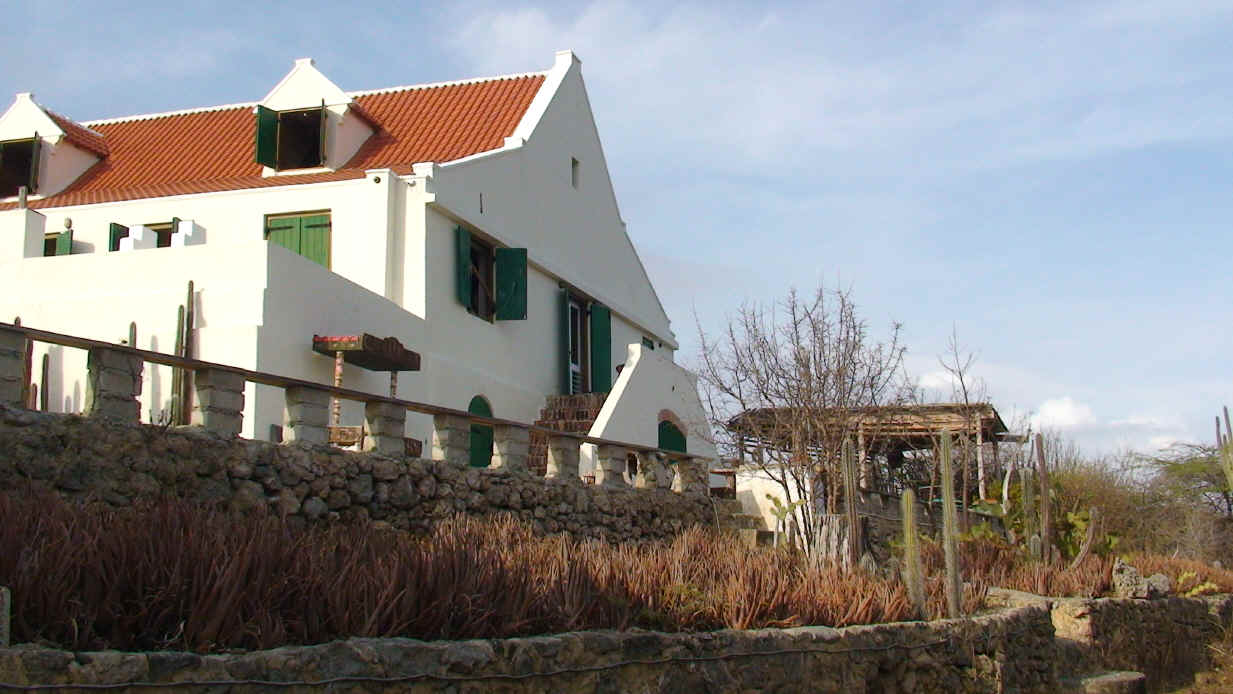
The
Ruins of Santa Catarina:
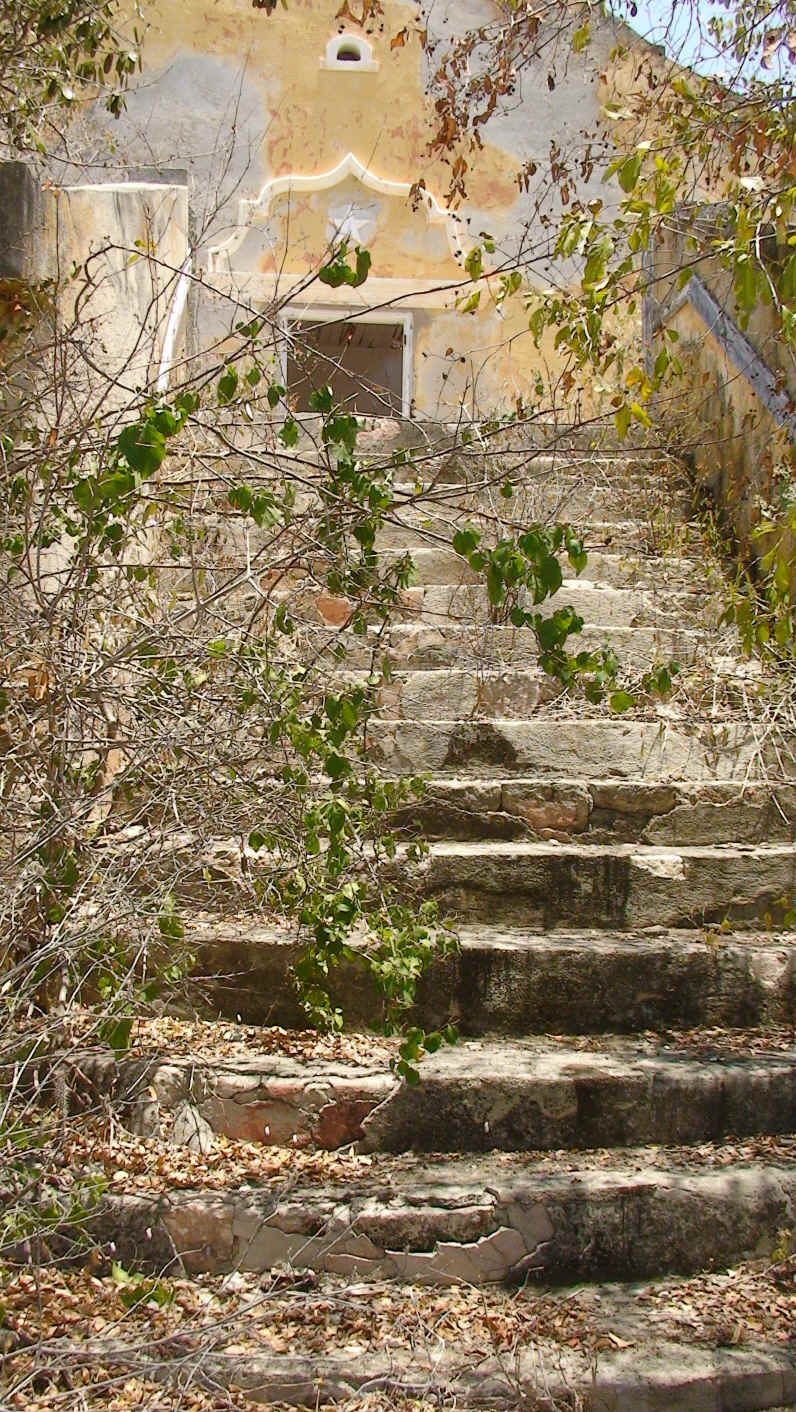
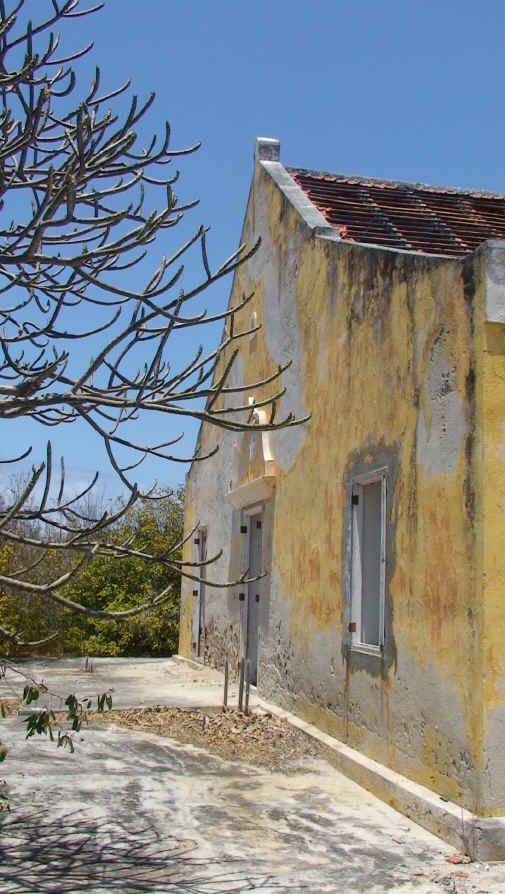
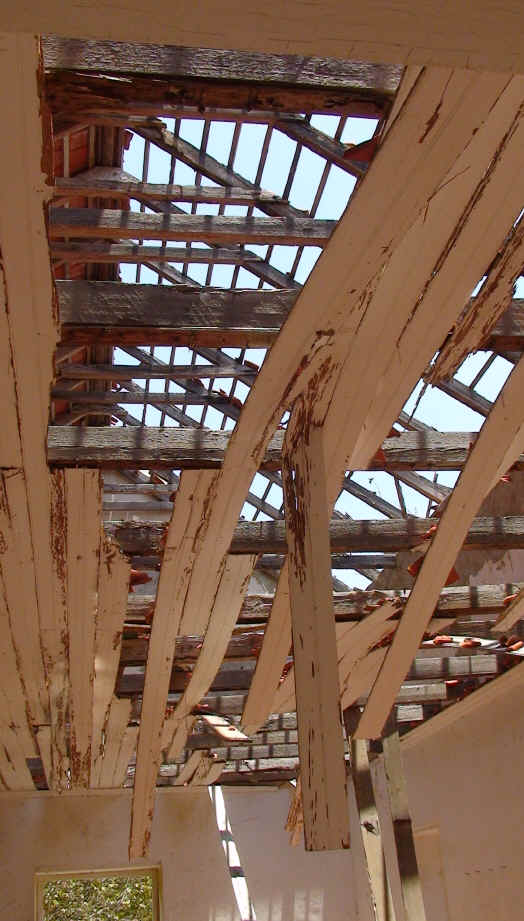
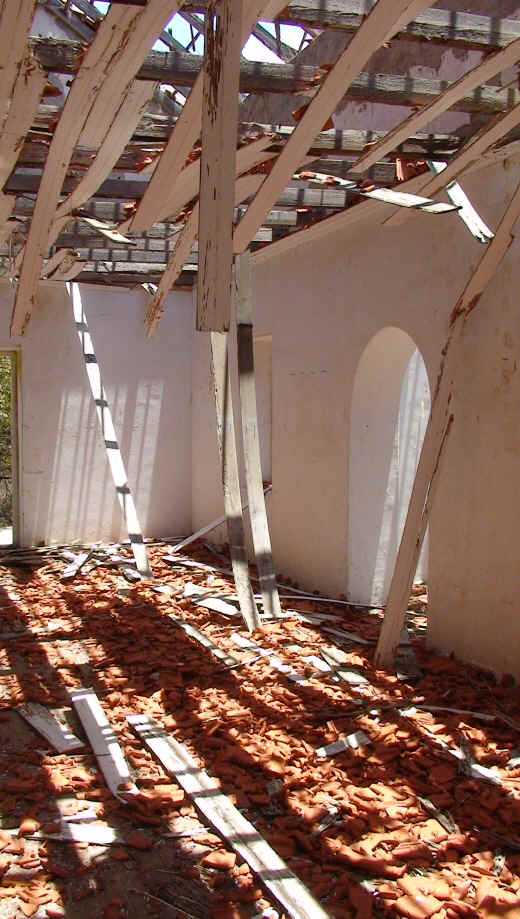
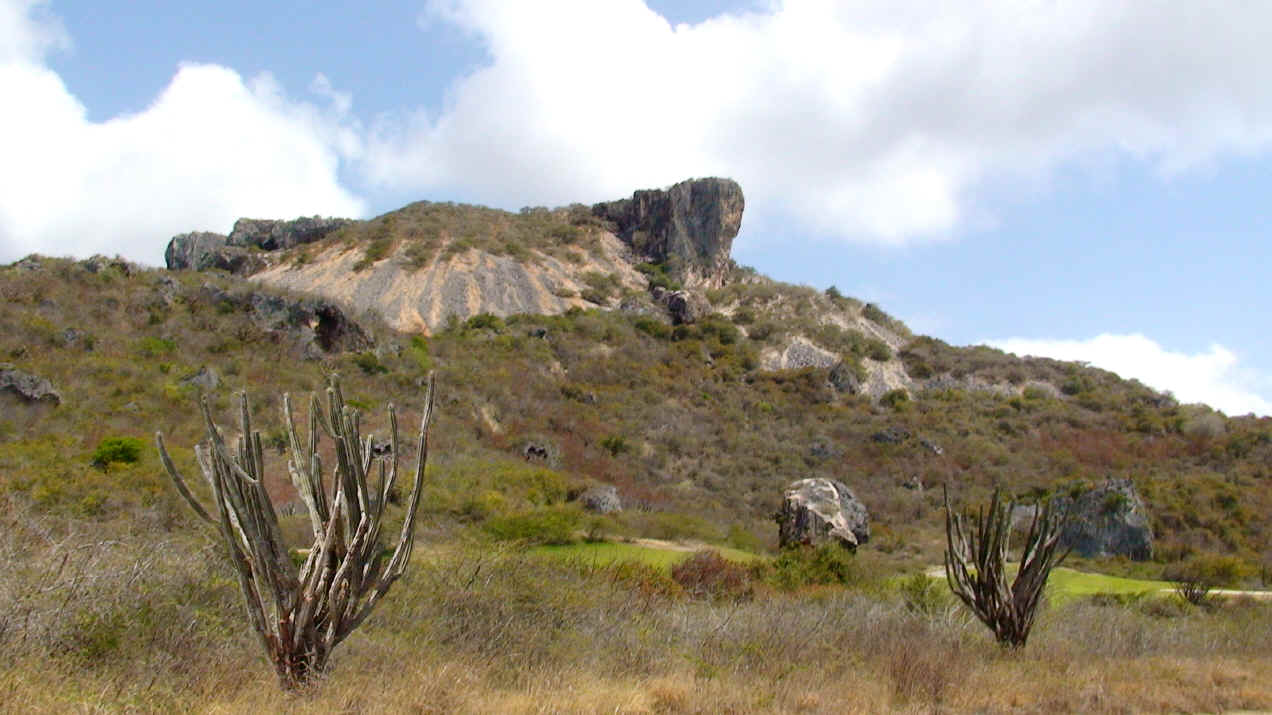
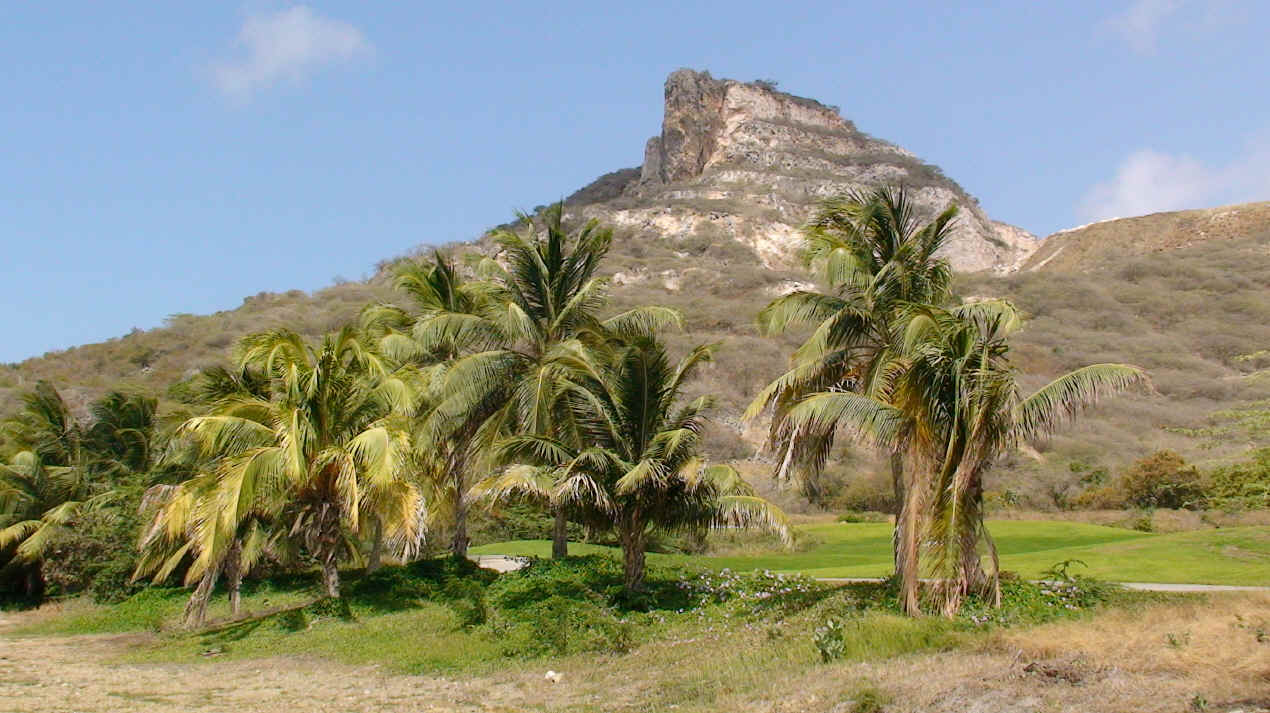
Everywhere
I went, to stores and restaurants, I tried out my Papiamentu, which produced
stares from most people, who then tried to answer me in English or Dutch, but I
would refuse to understand. But
still, I wasn't getting any good practice, no actual conversations.
You can't just yak away with some kid behind a busy Burger King counter.
I found out there was going to be some kind of social gathering at a
hotel the next night where tourists mix with locals, and decided I would go.
So I got all cleaned up at my apartment, went to the car to take off --
and had no keys. I searched the
whole apartment and every possible pocket, deciding finally they must be still
in the locked car. And it was dark,
so I couldn't look in and see for sure. So
no social club that night, my only chance to really meet people and talk.
That was annoying, since that had been the main focus of the whole trip;
but getting the car open was far more on my mind, since I had to fly to Aruba
the next morning! I didn't sleep
well that night. At the dawn's early
light, about 6, I was out of bed and down to the street.
Sure enough, the keys were right there in the driver's seat; good thing
the whole car didn't get stolen. And
most marvelously, the window was rolled down a tiny bit!
I got a clothes hanger and quickly and easily fished the keys right up
and over the window. If that hadn't
worked, I probably could have jabbed the power unlock button with the hanger,
and then opened the door.
So that was one huge worry off my head; it was just one more of
those dumb things I do that make my travels difficult.
Before I left that day though, I took one more swing through downtown to see the pretty colonial buildings.
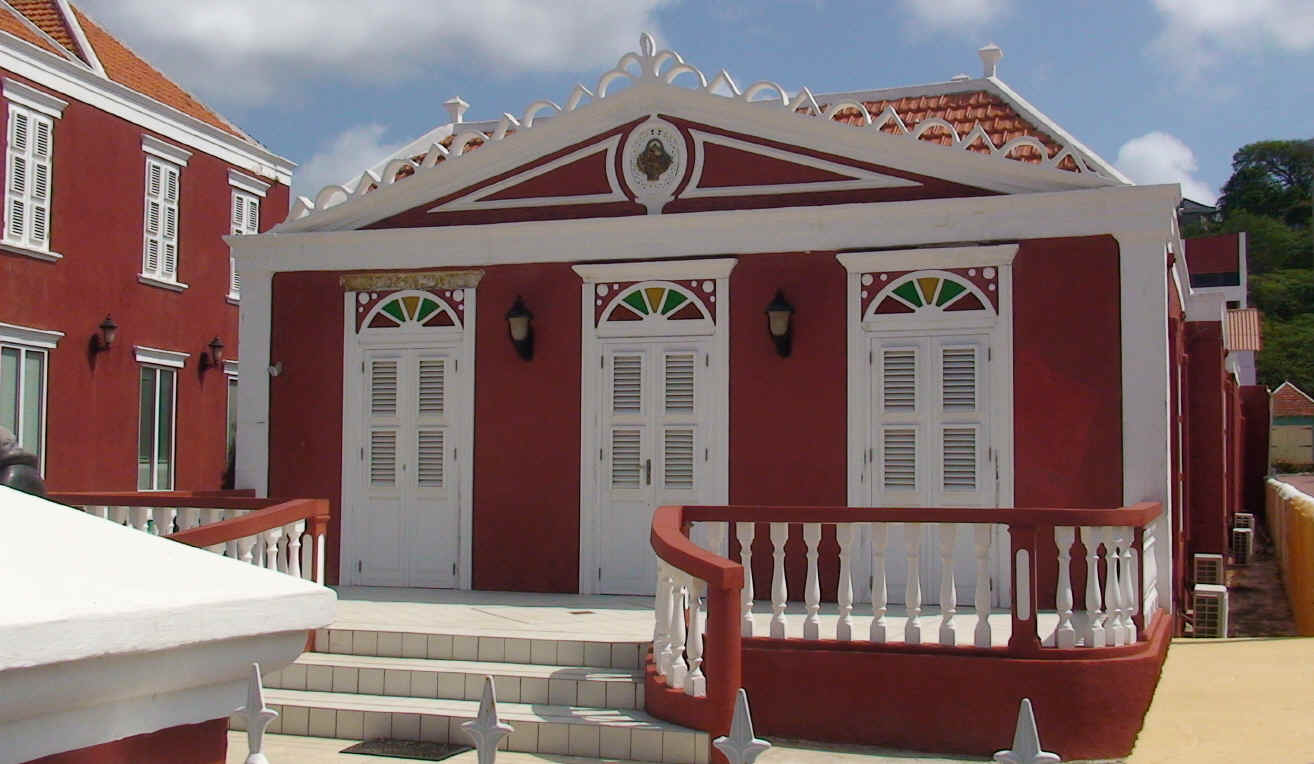
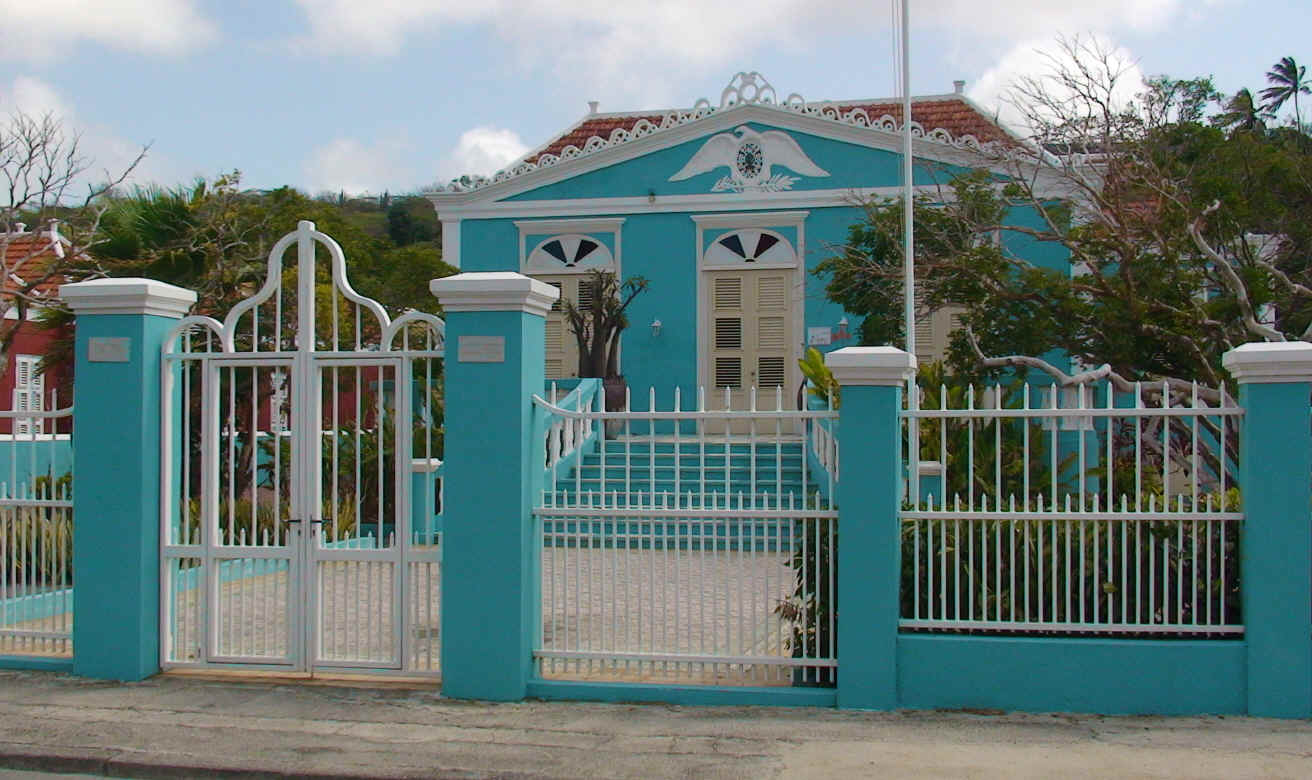
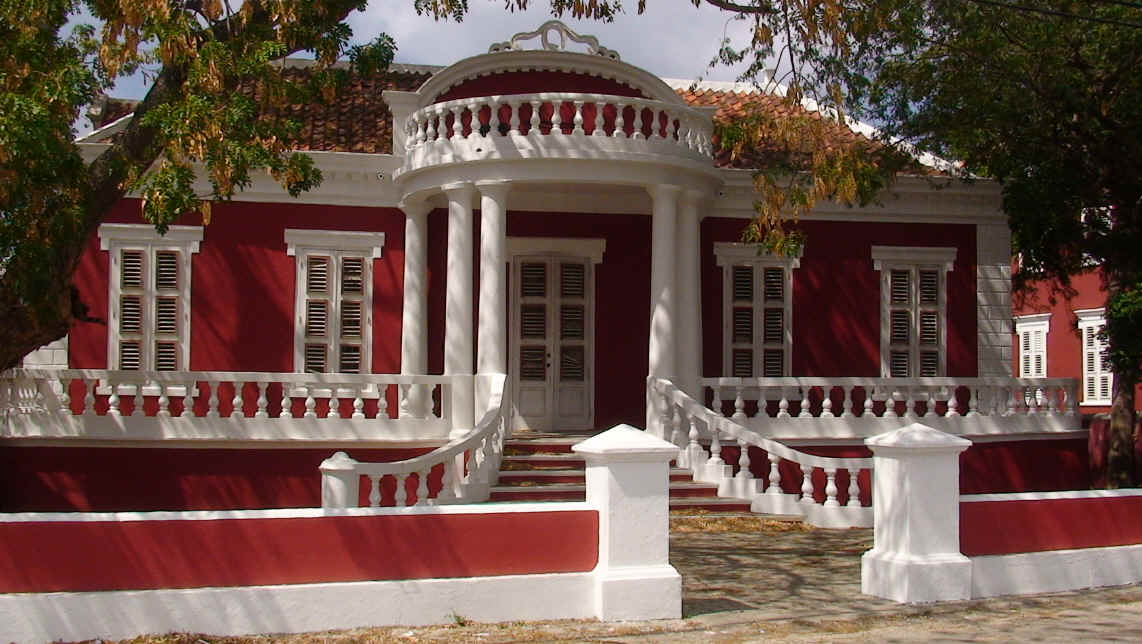
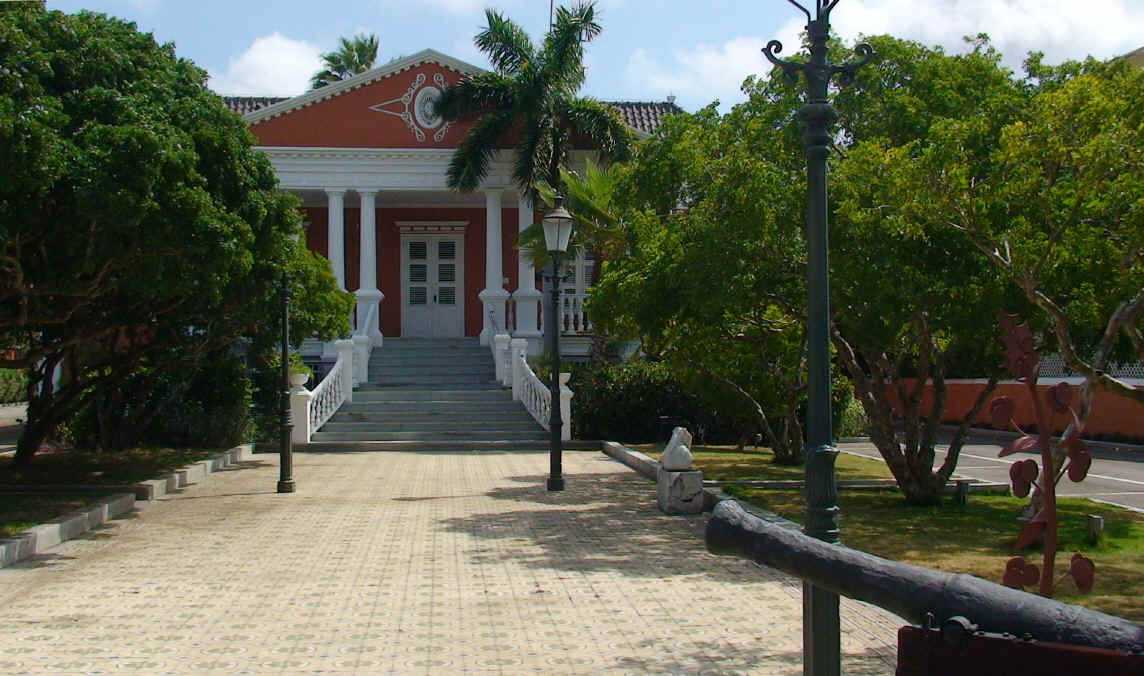
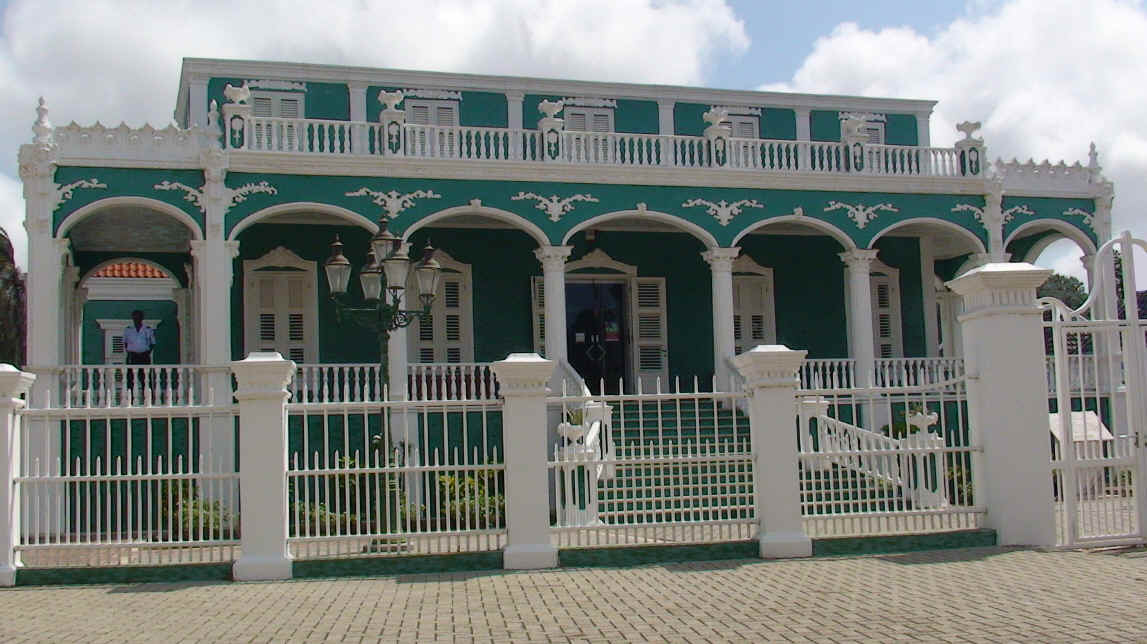
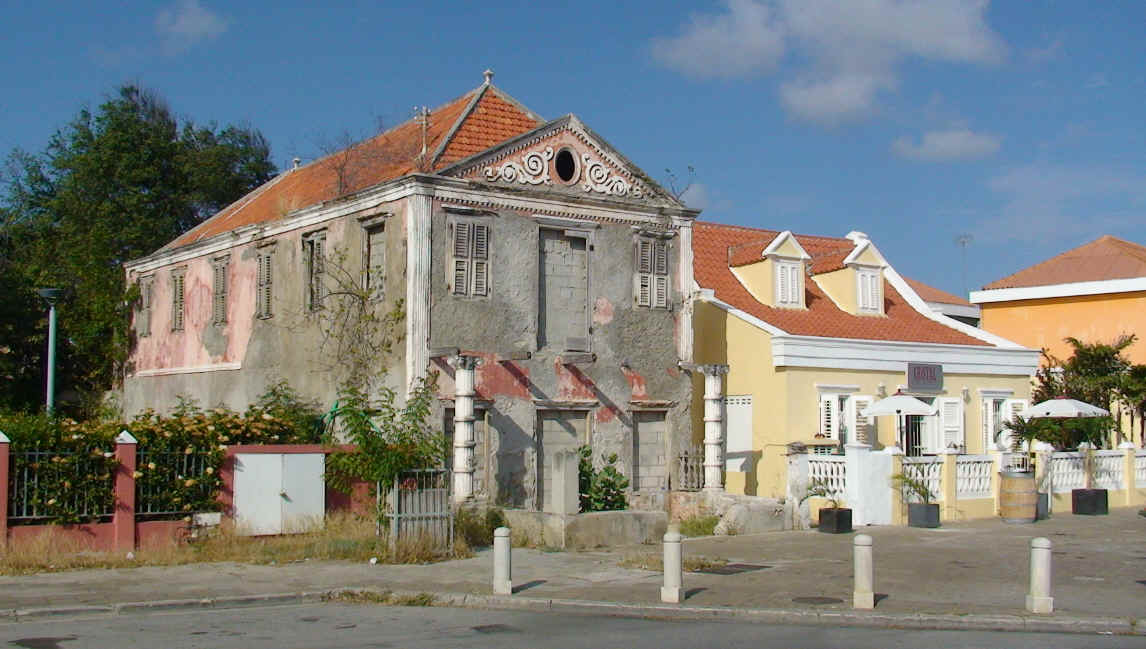
The Parliament, or capitol building, of
Curaçao:

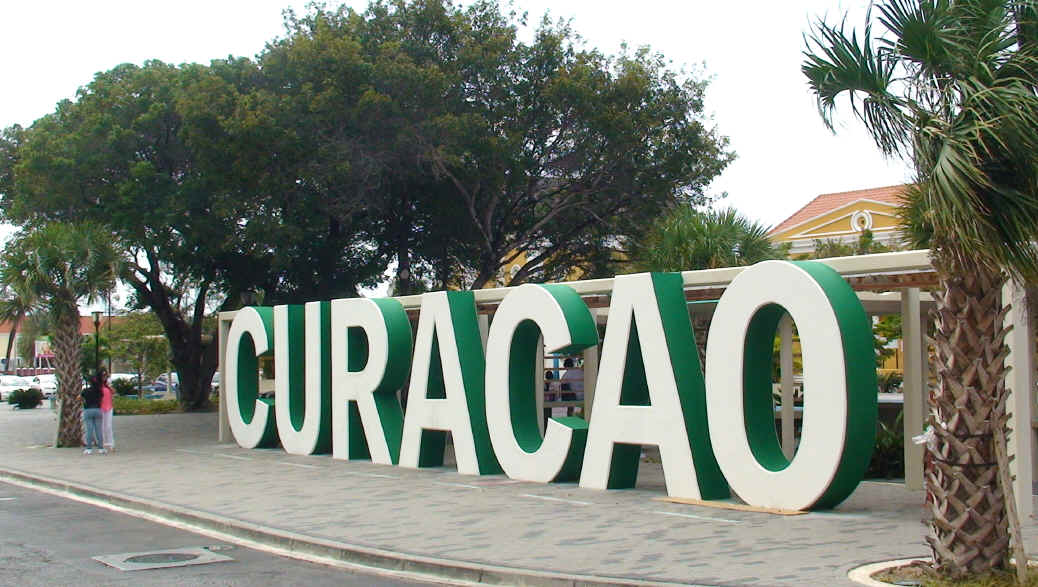
The
flight to Aruba took about 20 minutes. Finding the place I was going to stay
took three hours. I got my car and
followed my map to San Miguel Street, which was quite a ways away, on the
northeast part of the island right near all the huge high-rise hotels.
But there was no 37 San Miguel Street to be found.
I was to be staying in a small house rented out by its owners, who lived in a
bigger house right in front of it. The
communication with the owner hadn't been very good, but I thought that was no
big deal, since I had the address. He
had told me to go to a certain shopping mall nearby and he would meet me there,
but I had written back that I would just come straight to the house, since I had a car.
I wandered up and down that street five times, inspecting every house and
every number. There was a house #35,
so I asked a kid in front of it if
he knew where #37 would be, but he didn't. The
house next door was #42, which made no sense, since it was on the same side of
the street; but it had several doors. I
went up to one of the porches there, and was just about to knock, when a lady
suddenly came out the door, and just about fainted to see some big foreigner
standing there, me, right in front of her. So
she was not friendly at all, but she assured me that no, there was no #37 in the
building. After driving around a bit
more, I noticed three houses tucked off on a small dirt dead-end -- maybe that
was considered San Miguel Street too? I
saw some people sitting at a table by an open window in one of the houses, so I
parked and walked up to the window. I
was of course totally detesting this whole ridiculous scenario, I don't like
having to approach strangers whining for help!
But there was no choice. I
was trying to explain what I wanted in Papiamentu, and the lady of the house,
holding a baby, was trying to answer back in English, so we did pretty well; but
no, none of the houses there were the one I wanted.
She offered to call the people though, since I had a phone number, so
that was great. But nobody was home
but one little girl. I tried to talk
to her but got nowhere, so I gave the phone back to the lady of the house, who
talked to her for 10 minutes, trying over and over to figure out where the house
was. Finally she was able to get
enough information from the girl that she figured she could just drive over
there, and have me follow. So she,
the son, and the baby all got in their car, and I followed them for several
blocks, making turn after turn. I
soon noticed that every street we went on had San Miguel addresses, even though
they were blocks removed from the actual street!
Before long, they had found it -- the last house on a dirt road, a block
off the main highway. So I told them
how nice they had been -- trying their language had probably made
all the difference in them wanting to help me; people are flattered when
foreigners have an obvious interest in the culture of a place, and don't just
head straight for the beaches and casinos, as if the rest of the place doesn't
matter.
Still,
nobody was there but the little girl. She
said her father was out at the shopping mall waiting for me!
Well that was dumb, I never said I'd meet him there, much less picked a
time and place for it. But she let
me in the little house, which was large and pleasant, though not as clean as it
could have been. I had already
decided by then that I was through with this new idea of staying in people's
apartments when I travel. Just
hotels from now on for me, you can't not find a whole hotel!
I
should have visited Aruba first. After
being in Curaçao, it didn't measure up in any way, except for the huge beach
hotels, which Curaçao doesn't have. There
was high-rise after high-rise along the western beach.
The rest of the island is not as well-developed, as scenic, or with as
high a standard of living as Curaçao. I
might have liked it if I had landed there first, but it was a big disappointment
actually. It didn't have the feel of
a real, self-sustained place -- it obviously depended entirely on the tourist
trade. The western edge of the
island is extremely Americanized, with hundreds of shops, hotels, and
restaurants, and seems very cut off from the rest of the island.
Not a bit of it suggests you are in a foreign country, it could be
Florida or California or anywhere, and everything is in English, and they take
dollars everywhere. So why go
thousands of miles to get there? I'll
never figure it out. The great
flocks and hordes of tourists had no interest in the rest of the island, they
just stayed in that one isolated area. I
thought that the beach must be the main attraction, so for once in my life, I
decided to try an afternoon on the beach, even though I have always considered
that to be the most boring way possible to spend a vacation.
I walked out behind one of the huge hotels, and noticed hardly a dozen
people in the ocean. All the rest,
hundreds, were around the big chlorinated swimming pool belonging to the hotel.
What, they couldn't walk 100 feet on out to the ocean?
They came to Aruba to hang out around a swimming pool?
Couldn't they do that, say, in Kansas City?
Makes no sense to me, never will. I
flopped out on a lounge chair under a palm umbrella for a while, and even talked
myself into going in the ocean for the first time in nearly 30 years.
It was cold!! Took me 10
minutes before I finally got the water up to my neck, and I was miserable the
whole time. I thought the Caribbean
was supposed to be as warm as bathtub water!
And this was as far south in the Caribbean that you can get.
So no, I sure don't get the appeal of the place.
I endured the water for another 10 minutes, then had to go through the whole
tedious process of rinsing off the salt water under a beach shower, getting all
the sand off my feet and out of my clothes, getting socks and shoes back on, and
getting dressed decently enough, in spite of dripping shorts, to go back through
the hotel lobby and back to the car. I
don't understand beach vacations.
Years ago, Aruba had one nice attraction, a large sea arch, or natural bridge. Actually it was a double arch, a large one and a small one side-by-side. It was the main thing to go see, the most popular place on the whole island. Then on September 2, 2005, it collapsed. I of course had to go there and see the ruins. The small arch is still there, but the big one is a total wreck. Naturally, I walked across both of them, and broke off a little piece of rock from the collapsed one to bring home.
The small sea arch, which is still
standing:
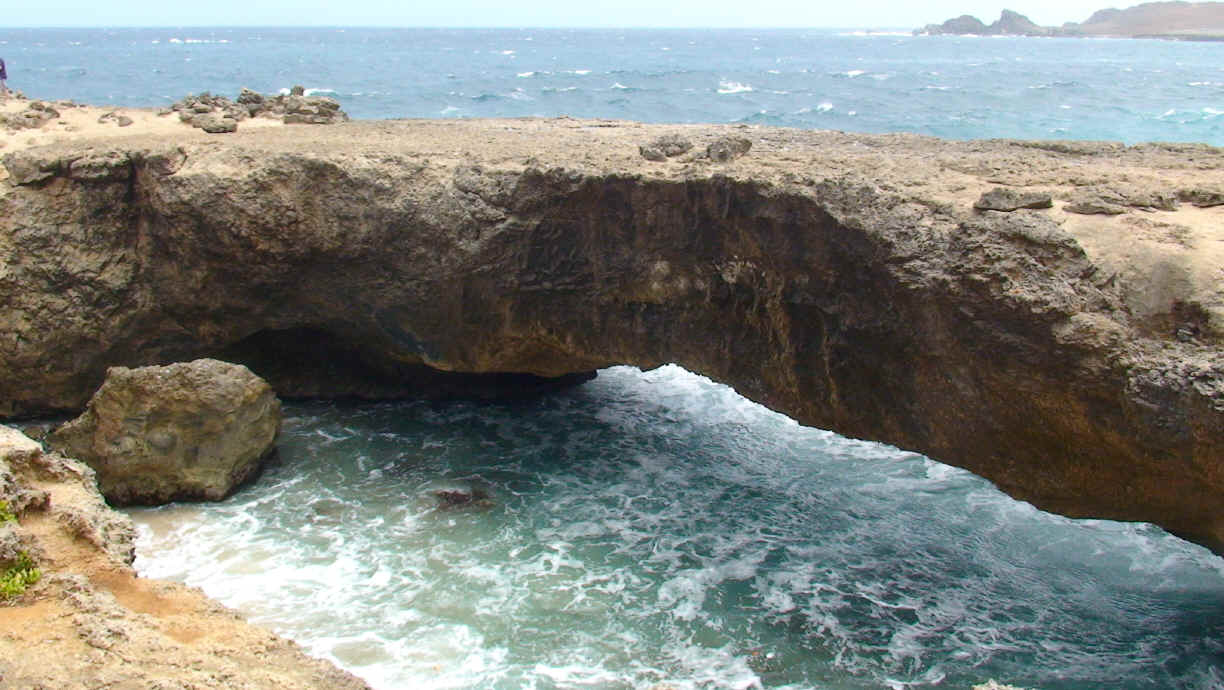
The sad
ruins of the big arch:
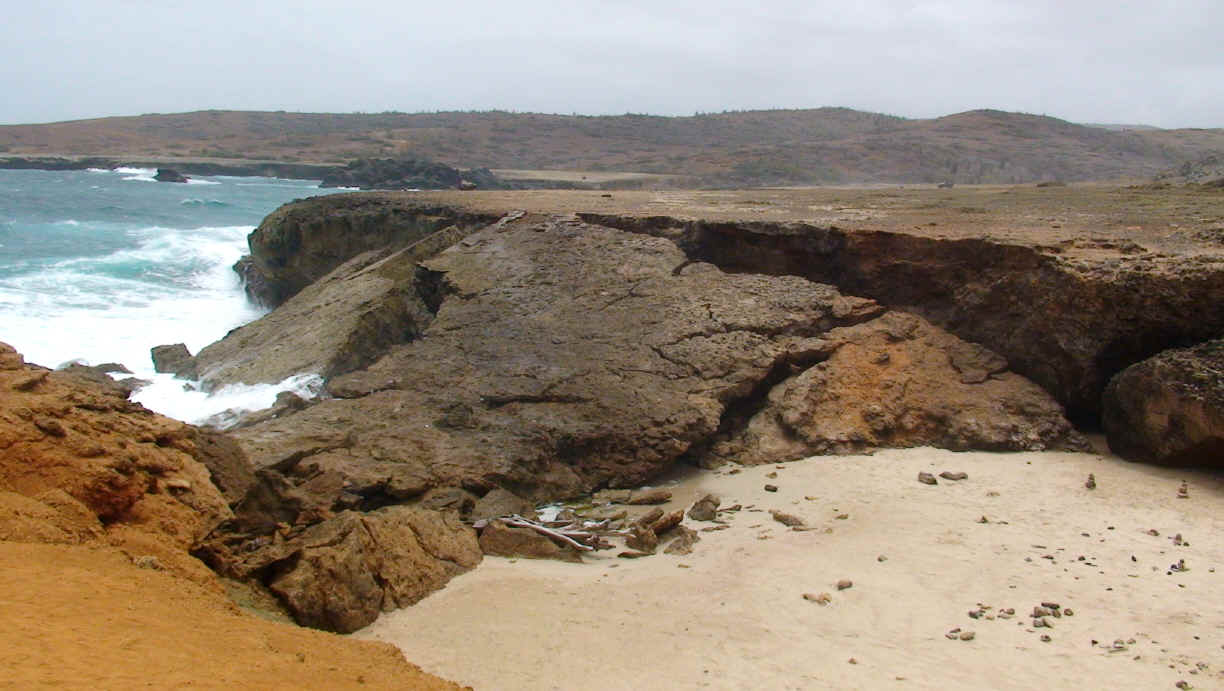
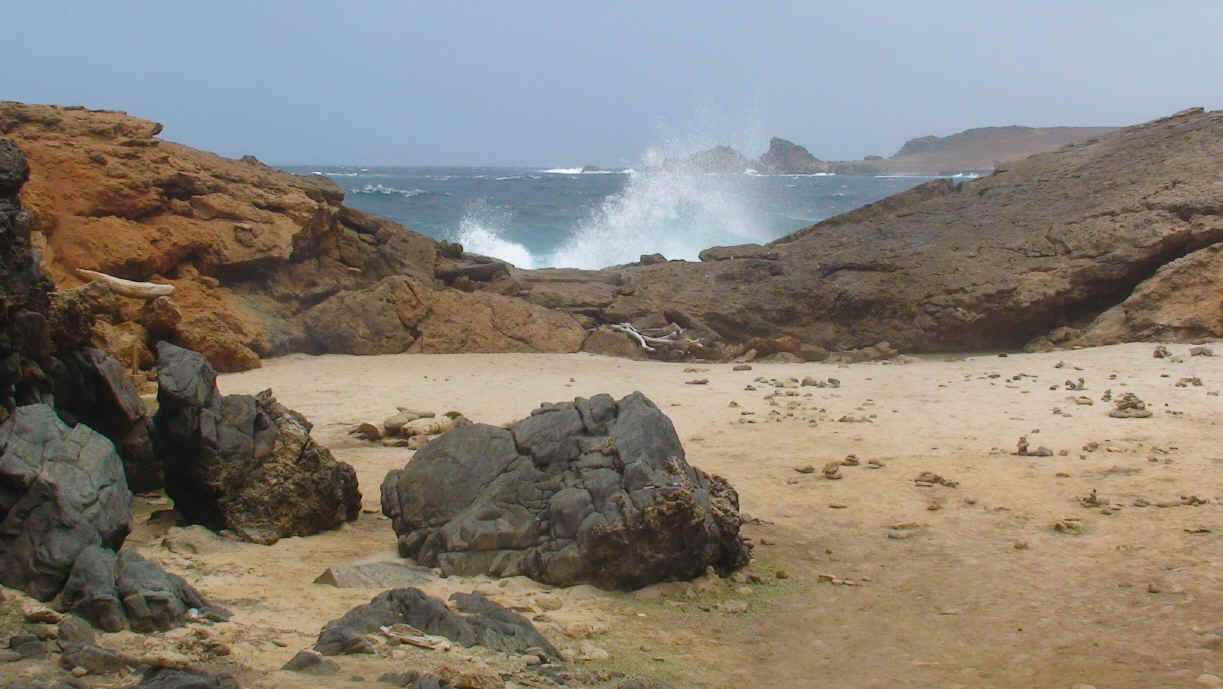
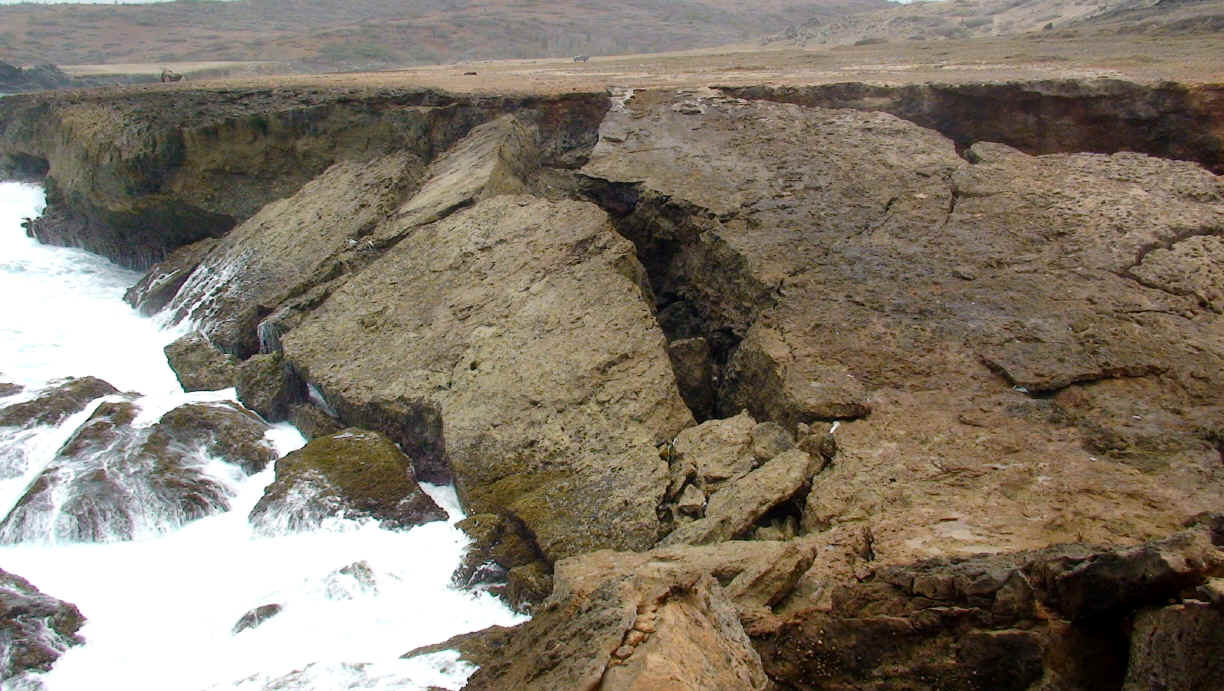
Both
arches were made of ancient petrified coral:
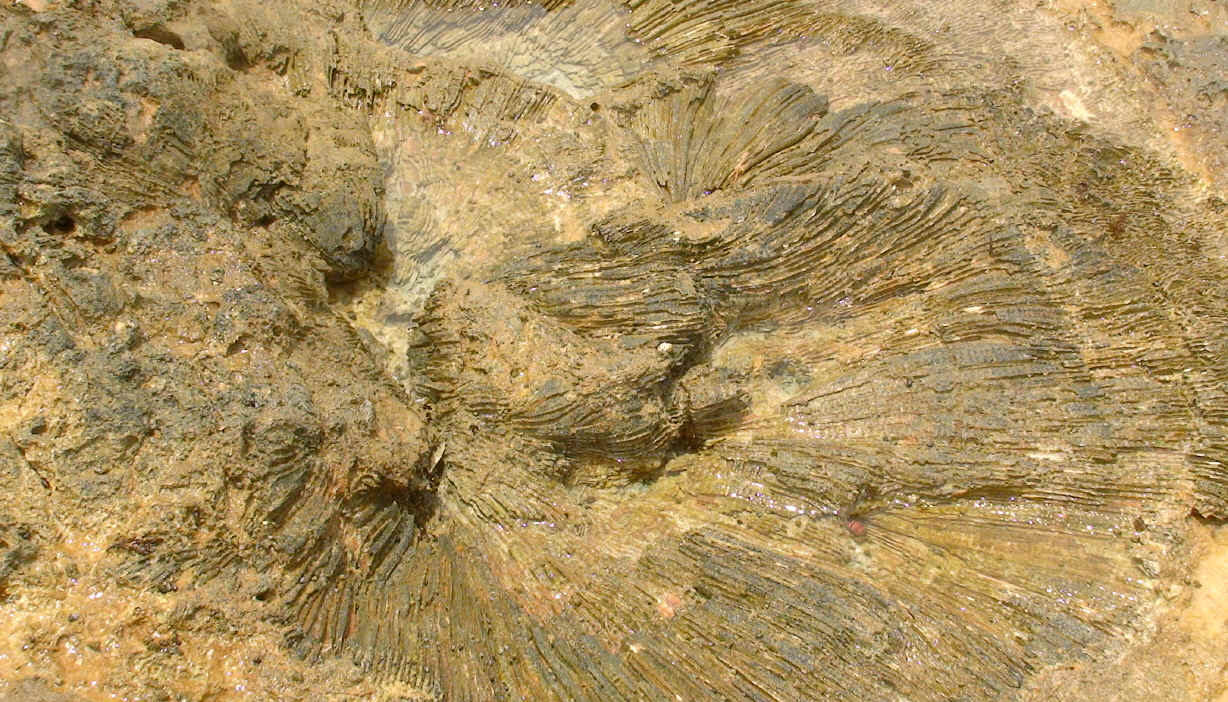
Leaving the island was another dreadful experience. I thought I had given myself plenty of time to get to the airport, even having driven the route the night before just to make sure I knew the way. But no, I missed a turnoff, had to drive miles in bad traffic before I could turn back, and then had a long hold-up turning the car in. Eventually I got to the American Airlines counter, noticed nobody was in line, and quickly tried to print out my boarding pass from an automated machine, which asked a dozen questions and never could scan my passport properly. Instead of spitting out the pass at last, it informed me I was too late to get one. I ran to the guy behind the counter, and he told me the same thing. Then after a bit of calling around, he told me that if I really ran, I just might possibly make it in time. So I did -- through various halls and corridors to the security area. Shoes off, baggage on the belt, metal stuff in the tray, into the x-ray chamber, then putting myself all back together again. But then, there weren't any more signs, so I hollered back at the guards, "Unda mi ta bai awor?!" -- where do I go now? -- and they pointed the way. Up some stairs, down some more long halls and corridors, and then suddenly -- another security inspection area! Hadn't I just done this? The plane is about to leave, and I have to go through the same shoes-off nonsense that I had just got through doing? But I knew not to complain; just keep your mouth shut and do it. After that little ordeal, I had to fill out a customs form, and then hand it and my passport to some severe-looking old guy, who showed no inclination to even notice that I was standing in front of his desk, while he was talking away, in very American English for some reason, to another guard nearby. Finally after several minutes, he deigned to notice I was there, said rather rudely, "Why are you so late?", did some stamping on the documents, and then waved me on through as if I had been a major annoyance. At last, not far ahead was the tunnel to the plane. I made it! I was the last one on, but then (of course), we sat there another 20 minutes before they ever started the engines. All was well!
But why the second security inspection? I found out later that Aruba is one of the very few places in the world that has American pre-clearance for customs. I guess I was just supposed to know that. Usually, when you come home to the US from a foreign country, as soon as you get off the plane you get herded through the interminable customs and immigration lines, where they check all your documents to see if you're an alien or not. But in Aruba, Ireland, Bermuda, the Bahamas, and Abu Dhabi, the US Customs actually has an official branch at their international airports, and it is all done before you get on the plane. That way, when you land in the US, you're free as a bird and you can just waltz right on out of the airport, or catch another flight if you need to without going through inspection lines. Seems to me that it doesn't save much time, and in my case, I certainly could have done without all that extra hassle ahead of the flight.
So what is my opinion of the islands? It's kind of complicated. Skip Aruba, I was not impressed at all, you can find high-rise beach hotels all over the world. Curaçao I really liked, but I think that is mainly because I already had a specific interest in it (the language). There are hundreds of places in the world that most tourists would find nicer, prettier, and more interesting, so I wouldn't just insist that everybody should rush right on out and get a ticket to Willemstad. But if you have already traveled a lot and seen many other countries, it is certainly a pleasant, safe, and charming place, a little land with its own unique culture and history, a real place and not a tourist trap -- and with their own little private language that I love, Papiamentu!
Notes
on Papiamentu -- a Fascinating Language
-- by Galen
